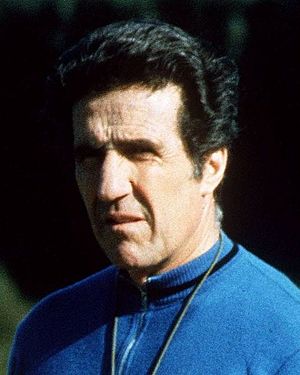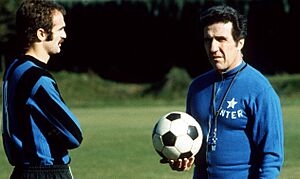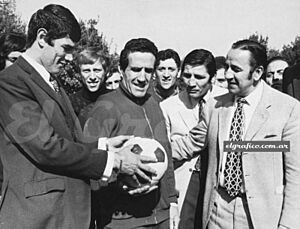Helenio Herrera facts for kids

Herrera with Inter Milan during the 1973–74 season
|
|||
| Personal information | |||
|---|---|---|---|
| Full name | Helenio Herrera Gavilán | ||
| Date of birth | 10 April 1910 | ||
| Place of birth | Buenos Aires, Argentina | ||
| Date of death | 9 November 1997 (aged 87) | ||
| Place of death | Venice, Italy | ||
| Position(s) | Defender | ||
| Senior career* | |||
| Years | Team | Apps | (Gls) |
| Roches Noires | |||
| 1931–1932 | Racing Casablanca | ||
| 1932–1933 | CASG Paris | ||
| 1933–1935 | Stade Français | ||
| 1935–1937 | Charleville | ||
| 1937–1939 | Excelsior Roubaix | ||
| 1940–1942 | Red Star Olympique | ||
| 1942–1943 | Stade Français | ||
| 1943–1944 | EF Paris-Capitale | ||
| 1944–1945 | Puteaux | ||
| Managerial career | |||
| 1944–1945 | Puteaux | ||
| 1945–1948 | Stade Français | ||
| 1948–1949 | Real Valladolid | ||
| 1949–1952 | Atlético Madrid | ||
| 1952 | Málaga | ||
| 1953 | Deportivo de La Coruña | ||
| 1953–1957 | Sevilla | ||
| 1957–1958 | Belenenses | ||
| 1958–1960 | Barcelona | ||
| 1960–1962 | Spain | ||
| 1960–1968 | Inter Milan | ||
| 1966–1967 | Italy | ||
| 1968–1970 | Roma | ||
| 1973–1974 | Inter Milan | ||
| 1978–1979 | Rimini | ||
| 1979–1981 | Barcelona | ||
| *Club domestic league appearances and goals | |||
Helenio Herrera Gavilán (born April 10, 1910 – died November 9, 1997) was a famous football player and manager. He was born in Argentina but later became a French citizen. He is best known for leading the Inter Milan team, nicknamed Grande Inter, to great success in the 1960s.
During his time as a manager, Herrera won four La Liga titles in Spain. He won these with Atlético Madrid and Barcelona. He also won three Serie A titles in Italy with Inter Milan. He helped Inter Milan win the European Cup twice in a row. Many people consider him one of the greatest football managers ever.
Herrera was one of the first managers to become a star himself. Before him, managers were not as well-known as the players. Teams were often known by their star players, like Di Stéfano's Real Madrid. But in the 1960s, Inter Milan became known as Herrera's Inter. This shows how important he was to the team's identity.
Contents
Early Life and Playing Football
Helenio Herrera was born in Buenos Aires, Argentina. His parents were from Spain. His father, Francisco, was a carpenter. He had strong political beliefs and had left Spain. His mother, Maria Gavilán Martínez, worked as a cleaner. In 1920, his family moved to Casablanca. This city was then a French colony. They hoped to find a better life there. Herrera started playing football in Casablanca.
He played as a central defender. In 1932, he moved to France to play for CASG Paris. Before World War II, Herrera, also called H.H., played for several French clubs. These included Stade Français, FCO Charleville, and Excelsior Roubaix. He was even called to play for the French national team twice. During the war, he continued to play for five more years. He played for teams like Red Star Paris and Puteaux. At Puteaux, he began his managing career in 1944 as a player-manager. He stopped playing in 1945. While his playing career wasn't very famous, his managing career changed football tactics a lot. This was especially true as UEFA competitions were just starting.
Becoming a Top Manager
After his first season at Puteaux, Herrera returned to Stade Français. This time, he was the manager. He stayed there for three seasons but didn't win any trophies. The club's president decided to sell the team. So, Herrera moved to Spain. He spent the next six years managing different Spanish clubs.
He managed Real Valladolid, Atlético Madrid, CD Málaga, Deportivo de La Coruña, and Sevilla. With Atlético Madrid, he won the La Liga title in 1950 and 1951. After Spain, he moved to Portugal. He managed Os Belenenses in Lisbon for two years. Then he came back to Spain. He managed the famous club Barcelona. He won many titles there, including La Liga twice. However, he had some problems, including disagreements with star player Ladislao Kubala. This led him to leave Barcelona in 1960.

Right after leaving Barcelona, he moved to Italy. He joined Inter Milan and stayed there until 1968. During his time at Inter, he won three Serie A titles and two European Cups. He used a special formation called 5–3–2. He also improved a tactic called the Verrou (which means "door bolt"). He made it more flexible for quick counter-attacks. This led to the famous Catenaccio system.
His team was called Grande Inter because of their huge success. They won the European Cup in 1964 and 1965. They also won three Serie A titles and two Intercontinental Cup titles. While at Inter, he also coached the Spanish national team (1959–1962) and the Italian national team (1966–1967).
In 1968, Herrera moved to Roma. He became the highest-paid manager in the world at that time. He won the Coppa Italia in his first season. However, his relationship with the club president became difficult. This was partly due to the sad death of his player Giuliano Taccola during an away game. In the next season (1969–70), the team's results were not consistent. This gave the president a reason to fire him.
He returned to manage Inter Milan for one season in 1973–74. After that, Herrera had a heart attack. He decided he didn't want to coach full-time anymore. He retired to Venice, Italy, where he lived the rest of his life. He took a break from coaching between 1974 and 1978. He then briefly managed Rimini Calcio. He ended his career by returning to FC Barcelona for about a year and a half in 1980 and 1981.
Herrera's Influence on Football

Helenio Herrera was a pioneer in using psychology to motivate his players. His famous sayings are still remembered today. For example, he said: "He who doesn't give it all, gives nothing." Another one was: "With 10 our team plays better than with 11." He said this after his team had to play with one less player. He also said: "Class + Preparation + Intelligence + Athleticism = Championships." These slogans were often put on billboards around the stadium. Players would even chant them during training.
He also made strict rules for his players. For the first time, he told them not to drink or smoke. He also controlled what they ate. Once at Inter, he suspended a player. This was because the player told the press, "we came to play in Rome," instead of "we came to win in Rome." He even sent club staff to players' homes to check if they were in bed at night. He started the ritiro. This was a pre-match retreat in a quiet country hotel. Players would gather on Thursday to prepare for a Sunday game.
He was also one of the first managers to ask for the support of the "12th player." This meant the fans in the stadium. This idea helped lead to the first Ultras fan groups in the late 1960s.
His Catenaccio tactic was mostly about defense. However, Herrera's version was a bit different from others. He often used his full-backs (like Giacinto Facchetti) to join the attack. They would run forward quickly to start counter-attacks. His team's strength was in defense, but they were also very good at fast attacks.
In 2004, Herrera's wife, Fiora Gandolfi, released a book called Tacalabala. It contained many of Herrera's sayings, drawings, and notes from his personal journals.
How Herrera's Teams Played (Tactics)
Herrera's main formation at Inter Milan was the 5–3–2 system. This usually included a sweeper (a defender who plays behind the main defensive line). The team's captain, Armando Picchi, often played this role. There were also four defenders who marked specific opponents. Herrera didn't care much about keeping the ball for a long time. He believed that "the ball always moves further, and more quickly, when there isn’t a player behind it."
While Herrera's Barcelona team played an exciting, attacking style, his Catenaccio tactics at Inter were sometimes criticized. People said they led to few goals and were too defensive. However, Herrera and his players disagreed. Herrera once said: "The problem is that most of the ones who copied me copied me wrongly. They forgot to include the attacking principles that my Catenaccio included. I had Picchi as a sweeper, yes, but I also had Facchetti, the first full-back to score as many goals as a forward."
Besides strong defense, Herrera's Grande Inter team was known for quick, direct football. They used very fast and effective counter-attacks. This allowed them to score with just a few touches. This was possible because Herrera used very fast and energetic attacking full-backs. Players like Giacinto Facchetti and Tarcisio Burgnich would run forward from defense. They would surprise opponents with their overlapping runs.
Also, the team's main creative player was Luis Suárez. He was a Spanish deep-lying playmaker. He was very important to Inter's success. He worked hard, had great technical skills, and could see the whole field. His passing was excellent. He helped the team win the ball back. Then he would launch quick attacks with long, accurate passes to the running full-backs. These full-backs would often score or help the strikers score.
After winning the European Cup in 1964 and 1965, Herrera's Catenaccio style faced a big challenge. This was in the 1967 final in Lisbon. Inter played against the Scottish champions Celtic of Glasgow. Celtic's team, known as the Lisbon Lions, was made up of players born near their home ground. Celtic won the game 2–1. Many people said this was a "victory for football" against the very defensive Catenaccio.
Interesting Facts
Helenio Herrera was called il Mago (the Wizard) and H.H. by Italian sports journalists. They saw him as one of the best coaches in Italian football history. He was known for his success and smart tactics. Sometimes, he would even announce the results of Sunday's games before they happened. Often, his predictions were correct!
Managerial Statistics
This table shows Helenio Herrera's record as a manager for different teams.
| Nat | Team | From | To | Record | |||||||
|---|---|---|---|---|---|---|---|---|---|---|---|
| Games | Wins | Draws | Losses | Win % | Goals For | Goals Against | Goal Difference | ||||
| France | Stade Français | 1946 | 1948 | 114 | 62 | 23 | 29 | 54.39% | – | – | |
| Spain | Real Valladolid | 1948 | 1949 | 27 | 10 | 2 | 15 | 37.04% | – | – | – |
| Spain | Atlético Madrid | 1949 | 1952 | 120 | 60 | 19 | 41 | 50% | – | – | – |
| Spain | Málaga | 1952 | 1952 | 11 | 5 | 1 | 5 | 45.45% | – | – | – |
| Spain | Sevilla | 1953 | 1956 | 123 | 62 | 15 | 46 | 50.41% | – | – | – |
| Portugal | Belenenses | 1956 | 1958 | 28 | 12 | 4 | 12 | 42.86% | – | – | – |
| Spain | Barcelona | 1958 | 1960 | 94 | 71 | 10 | 13 | 75.53% | – | – | – |
| Italy | Inter Milan | 1960 | 1968 | 343 | 193 | 87 | 63 | 56.27% | – | – | – |
| Italy | Roma | 1968 | 1973 | 190 | 64 | 71 | 55 | 33.68% | – | – | – |
| Italy | Inter Milan | 1973 | 1974 | 23 | 12 | 6 | 5 | 52.17% | – | – | – |
| Italy | Rimini | 1978 | 1979 | 14 | 4 | 3 | 7 | 28.57% | – | – | – |
| Spain | Barcelona | 1979 | 1981 | 48 | 30 | 10 | 8 | 62.5% | – | – | – |
Awards and Honours
Helenio Herrera won many awards and titles as a manager.
Club Honours
Atlético Madrid
- La Liga: 1949–50, 1950–51
- Copa Eva Duarte: 1950
Barcelona
- La Liga: 1958–59, 1959–60
- Copa del Rey: 1958–59, 1980–81
- Inter-Cities Fairs Cup: 1955–58, 1958–60
Inter Milan
- Serie A: 1962–63, 1964–65, 1965–66
- European Cup: 1963–64, 1964–65
- Intercontinental Cup: 1964, 1965
Roma
- Coppa Italia: 1968–69
Individual Honours
- Italian Football Hall of Fame: 2015
- Ranked among the Greatest Managers of All Time by top sports magazines:
- 4th place by World Soccer: 2013
- 5th place by ESPN: 2013
- 7th place by France Football: 2019
Images for kids
-
Herrera (center) with boxer Carlos Monzón (left) and colleague Juan Carlos Lorenzo
See also
 In Spanish: Helenio Herrera para niños
In Spanish: Helenio Herrera para niños


